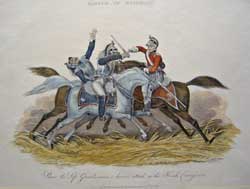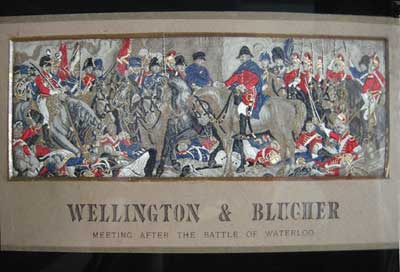
“... THE MOST INFAMOUS ARMY I EVER COMMANDED “
Wellington (on the composition of his army at Waterloo)
THE BATTLE OF WATERLOO
[Wellington at the scene]
Engraved by John Burnet after the painting by J.A. Atkinson, portraits by A.W. Devis
RARE. Copper engraving [London] 1819
161/2 x 231/4” excluding letters (42 x 59 cm)
Depicted is a general scene toward the end of the battle on 18 June 1815, with Wellington in attendance, from the British vantage, Portraits of the main allied participants are identifiable, including that of the 'Iorn' Duke Wellington; who, despite his generally poor opinion of his troops (quoted above) is shown saluting the capture of a French Eagle standard by Sergeant Ewart of the Scots Greys. Napoleon’s Garde Impériale are shown in disorderly retreat signifining the moment of Allied victory.
This image was considered scarce even in 1819, as contrary to the original intention of the engraver, there were never very many copies of this image published, making it highly desirable for today’s collector of military and particularly Waterloo images.
Waterloo produced many iconic myths and also courageous heroes, not least among them the actions of many members of the cavalry. It seems unlikely that the Duke of Wellington said that Waterloo was won on the playing fields of Eton, not least because Eton had no playing fields, in the modern sense at that time. But he undoubtedly did say : “It was a damned nice thing [‘nice’ meaning close and all too finely balanced], the nearest thing you ever saw in your life.” Warner , P. The British Cavalry. p.116 .
Little wonder then, that this battle was regarded as one of the most significant in British history, much as ‘The Battle of Britain’ was to be over a hundred years later.
John Burnet 1784-1868 became a Scottish painter, etcher and engraver of historical subjects, after his contemporaries and old masters. Born in Midlothian, he lived in Edinburgh. He was one of the first engravers to specialize in the reproduction of paintings for the new middle class collector, and he pioneered the use of steel plates, although this image is engraved into copper and was not widely circulated. He died in Stoke-Newington.
John Augustus Atkinson 1775 - 1831/3? was a painter, etcher and aquatint engraver of historical subjects. In 1784 he accompanied his uncle to Russia in the service of the Empress Catherine.
Arthur William Devis 1762 - 1822 Following the shipwreck in ca. 1783 of the Antelope, aboard which he was listed as draughtsman, Devis travelled on to Bengal, India were he became a society painter of portraits. Upon his return to England he exhibited some 65 pictures at the Royal Academy between 1779 - 1821.
Click for more
information on the printing technique. RETURN
TO MILITARY CATALOGUE


















